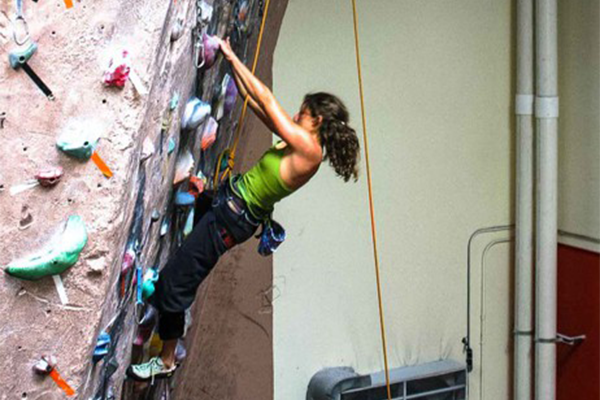Recreation centers, gymnasiums and health clubs struggle with maintaining building temperature and comfort while keeping costs down. And who doesn't want to do their part to improve energy efficiency?
A great way to achieve these objectives is to use destratification fans in your buildings.
Destratification fans will:
- Balance temperatures.
- Save energy and money.
- Reduce ductwork.
- Improve room comfort.
- Reduce pollutants and pathogens for cleaner indoor air.
What Is Stratification?
Thermal stratification occurs when hot, light air rises and cool, dense air sinks, which can happen in a room with insufficient air circulation. The air temperature at floor level will be different than at ceiling level and is typically 0.5 degrees F higher per vertical foot above the thermostat. To effectively move air in a large space to maintain a constant, comfortable temperature requires enormous amounts of energy, which can be taxing to HVAC systems. HVAC systems are often overdriven to overcome stratification, which can be a waste of energy.
Destratification Fans
Destratification fans circulate air vertically in a space by drawing air from the ceiling and moving it back down to the floor. The continuous circulation of air mixes the stratified air, balancing the overall temperature. By continuously cycling a column of air, destratification fans create a comfortable environment for your building occupants. These fans help to balance the temperature of the air, so you don't have to overheat or over-cool the room to maintain comfort.
The lower temperature difference between the ceiling and floor, increased air circulation, and elimination of thermal layers makes people more comfortable, improves customer satisfaction and increases the productivity of employees while reducing energy usage.
Destratification fans can be used in a variety of settings, including gymnasiums, arenas, rec centers, indoor swimming pools and health clubs. Destratification fans are used to create a uniform temperature throughout the building, or they can be used to improve ventilation and air quality. Destratification fans are available in a variety of sizes and styles. They can be purchased as standalone units or integrated as part of an HVAC system, and can be an effective way to improve energy efficiency and occupant comfort.
Energy and Money Savings
One of the biggest benefits of using a destratification fan is improved energy efficiency. Circulating the air regulates the temperature in the room, which can lead to less energy being used to maintain a comfortable environment. By circulating the air, they can reduce the amount of time that heating and cooling systems need to run. A reduction in the ductwork of HVAC systems results in lower upfront costs and lower energy consumption. Destratification fans are a great energy-efficient solution for the long-term operation of a facility because they are low-power compared to traditional HVAC systems. An investment in destratification fans can lower energy bills by up to 30% and lower the wear and tear on your HVAC system, which will also lower maintenance costs.
Air Purification
An air purifier can be added to destratification fans to remove some of the allergens from the air. Fans equipped with air purification modules can reduce the amount of dust and pollen in the air, which can improve air quality for all the occupants.
Some destratification fans also come with air purification technology that reduces the number of airborne pathogens. These products have technologies that render viruses, bacteria, molds and other pathogens inert. Destratification fans can also reduce the amount of condensation buildup on glass, impairing the growth of mold and mildew.
Comfort
In an exercise and recreation environment, there is frequent occupant turnover. Lots of doors opening and closing as people come and go makes it difficult to cost-effectively maintain building comfort. Destratification fans can help facility managers provide more comfortable environments. By circulating the air, the fan creates a more stable temperature. And since destratification fans use lower power and can be designed and installed in high-traffic areas, facility managers can have improved control over the building environment.
The benefits of destratification fans are clear—energy efficiency, a more comfortable building environment and, with air purification added, improved health for all occupants. By understanding the technology and its benefits, recreation managers can make the best decisions for their buildings. To get the most out of your investment, make sure that the fan is properly installed, that employees are using the fan correctly and keep track of how often the fan needs to be cleaned or replaced. By understanding destratification fans, rec centers can save energy and money while providing a more comfortable environment.
ABOUT THE AUTHOR



